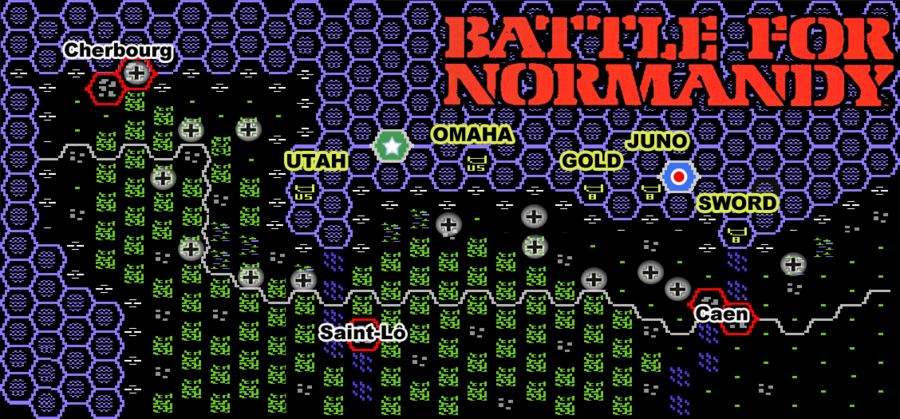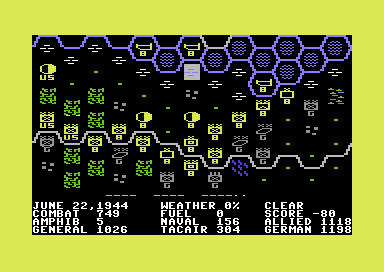Here I am again for a brand new SIDETRACK! The loops ever getting wider and wider.
The whole point of the above whole, was to go dig in the lost tradition of RPGs, not when they were simple and naive but when they were ambitious and convolutedly eccentric. That’s the real root main of RPGs that we collectively abandoned and forgot: wargames.
So one of these sidetracks was retrieving some of those games I looked for a long while when I was a kid, but never ended up trying on a real Commodore 64.
https://i.imgur.com/vYJHXKm.jpg
The title I remember (reading reviews of) is “Halls of Montezuma.” As you can see there are a few, all using the same “Battlefront” engine or some variations of it. In some of the comments I read most of these were only a collection of scenarios and only the Russia game had a proper campaign, so I picked that one.
I employed the well practiced strategy of poking at things to figure them out without a manual, and it’s all relatively straightforward. Some menus to toggle on/off some map features, some text screens to see reinforcements and various statistics, and so on.
The only problem is that I couldn’t find a command to actually MOVE stuff on the map, and I’ve tried for quite a while.

I suppose that menu is to set up ground and air support for that precise attack, and then there’s a menu with various options, like: ASSAULT - PROBE - DEFEND - RETREAT
And there seems to be some upper level “directive” that only switches from “resting” to “normal”.
Units that aren’t shown engaged in combat can only switch from “hold” to “deploy”.
That’s about it?
After trying for a while I went looking for some discussions online, and it does seem that you don’t push counters in this game… It should be some higher scale strategic thing, so you pretty much only set up the intensity of an attack, but it’s the AI that is in charge of the tactical game.
I guess this can help the game to be more balanced, since it’s all the AI doing those moves. With the player only playing from the backseat the game probably holds up better when it comes to challenge, but it still feels quite limited… and dry.
You’d expect me to stop here, after having an idea of how the game works. But instead I’m looking for very specific things one doesn’t usually care about.
This time I started wondering how they put together that “tiled” hex map. Because after a quick analysis it doesn’t seem like they use the same “grid” that they used for text. So I started to wonder, are they using two separate graphic modes, shared on the same screen, one for the map and another for all the text?
Yet that tiled hex map defied my first attempts at deconstructing it. The vertical spacing makes sense, it’s horizontally that it does something weird.
To find a solution I had to remove that ugly CRT filter and resize to a native resolution. The final result is a grid of 8x10:

Horizontally the sequence is two tiles forming an unit, then one tile used for the hex grid. The hex grid goes all around the two unit tiles, so each unit tile has 10 grid tiles surrounding it. Those tiles can be empty, but they can always only contain the hex grid.
Now you can see that vertically the hex tiles form a column from the top to the bottom of the screen (horizontally with multiples of 3), whereas this doesn’t happen horizontally, because horizontally we have two unit tiles followed by four hex tiles. Producing that slanted offset…
Why should one waste time to figure out these relics of map representation? Because for my own game thing I was trying to figure out how to best represent an hex map having only available a square grid. So not only I need to find some graphical solution to this that looks nice, but also the “algorithm” that would build such thing.
It’s not as trivial as it might appear, and it was very interesting to go back and dissect this game.
This series was made by SSG, but the better known in the field is SSI. I haven’t dug as much here because I got sidetracked again, but SSI has its own way of building an hex grid, and its own solution produces an arguably prettier result, since these looks more like proper hexes compared to the hamburger-ized version of SSG.


(a matter of scale…)

…In the future I’ll try to code my very own solution. Because about two months ago I stumbled on this problem of “building hex grids with square tiles”, and after fiddling with the most common solutions for a while I eventually ended up with some weird hybrid that I’ve never seen used before. Only accidentally I now stumbled on these SSG wargames, and that solution has something in common with mine… But not quite the same.
So what’s the sidetrack that sidetracked me? That from SSG I moved to SSI, and the SSI catalogue is quite huge.

https://i.imgur.com/qbTVeik.jpg
For most of everyone SSI is only synonym of the GoldBox games, but as it happens with the pen and paper RPGs the true root was in the wargame genre. SSI was primarily a wargame publisher.
My story is that before getting watered down, pen and paper RPGs were after simulation and complexity.
Is it possible that this is true even on the computer side? Is it possible that the GoldBox games were watered down designs coming from more complex systems that preceded them and then got erased from our collective memory?
OH YES!
I introduce you to: Wizard’s Crown + The Eternal Dagger


https://i.imgur.com/A3SH3ao.jpg
https://i.imgur.com/RexildI.jpg
In the SSI catalogue these are the only two fantasy games showing up as “intermediate”. Everything that belongs to fantasy is otherwise “introductory”. The system contemplates three tiers, but the “advanced” one is only reserved for the actual wargames.
The Digital Antiquarian reinforces the story:
At their best, though, the rules behind these games felt more consciously designed than the games in the bigger, more respected series — doubtless a legacy of SSI’s wargame roots. This quality is most notable in Wizard’s Crown. The most wargamey of all SSI’s CRPGs, Wizard’s Crown was not coincidentally also the first CRPG to be designed in-house by the company’s own small staff of developers, led by Paul Murray and Keith Brors, the two most devoted tabletop Dungeons & Dragons fans in the office. Built around a combat engine of enormous tactical depth in comparison to Ultima and The Bard’s Tale, it may not be a sustainedly fun game — the sheer quantity and detail of the fights gets exhausting well before the end, and the game has little else to offer — but it’s one of real importance in the history of both SSI and the CRPG.
And confirmed by the wikipedia:
Wizard’s Crown was the first RPG designed in-house by SSI, previously known as a wargame company. Its detailed tactical combat system came from Murray and Brors’s background in wargaming, and they brought the complexity of those games to Wizard’s Crown’s tactical combat. For instance, shields block attacks only from the front and left (shielded) side, and not from the rear and right (unshielded side). Spears can attack two squares away, flails ignore the defender’s shields, and axes have a chance of breaking shields. There is an option for “quick combat”, and regular combat can take as long as 40 minutes per encounter. This combat system influenced SSI’s later Gold Box series of RPGs, but it was streamlined and simplified.
https://i.imgur.com/vasShwg.jpg
I think The Eternal Dagger implements one idea I also had for my game (that I didn’t know existed already in this form): when you are in a dungeon the whole party is a “blob” represented by a single unit, but when you enter combat you instead deploy all the party units onto a separate tactical map. Actually Ultima does something along these lines already. The difference in my idea is that I wouldn’t use a separate map, but deploy directly the party on the same map, smoothing this transition somewhat.
https://i.imgur.com/X4xGj3A.jpg
https://i.imgur.com/eX7bWRM.jpg
The game system has a plenty of good ideas. No levels, skill based. Experience points are spent directly to improve skills. Every skill increased has a fixed cost, then the amount of the increase is rolled randomly, and goes 1 to 8 if the skill is below 100, then 1 to 4, 1 to 2, and just 1 when you go above 200, progressively slowing down.
https://i.imgur.com/CQ88oIj.jpg
On the excerpt above there’s interesting differentiation between weapon types (in the image you can see the considerable attack range when using a spear), but it goes further as damage is divided onto “thrust”, “cut” and “bash”, and of course this is matched by the armor types and their damage absorption values.
https://i.imgur.com/ha2OYBj.jpg
Another important feature is the facing and how it’s handled. If you aren’t moving you can switch the facing how many times you want, up to three movement steps you only have 1 facing change, and above three you just can’t change facing at all.
It becomes relevant because facing is used in combat calculations
https://i.imgur.com/Z7hnNUK.jpg
There’s distinction between front, rear, shielded and unshielded side. Side a rear add a to-hit attack bonus, the shield adds to the defensive skill, since the to-hit roll is essentially attack skill versus defensive skill, plus some randomness added. The defensive skill is the weapon skill, but halved, so that’s why a shield is probably quite important since without one the mechanic favors massively the attacker.
But there are also a bunch of situational modifiers. Fatigue and morale, but also injuries. If the defender moved more than half his points, then his defensive skill is halved again, BUT only if it’s a melee attack, because if instead the attack is ranged then his skill is DOUBLED, because by moving he gets harder to hit.
And there’s more. Four types of melee attacks: normal, defensive, aimed and killing.
The difference between these four is how they modify to-hit chance and damage. “Aimed” attacks lower to-hit to increase damage, “killing” lower defense to increase damage, and “defensive” attacks lower to-hit to increase defense, with the manual suggesting to use this option when you are threatened by enemies on your sides and rear (since they’ll have their to-hit bonus due to their positional advantage).
In Wizard’s Crown aiming behaves differently, it skips one turn to give a higher to-hit and damage, but only in the next turn.
Wizard’s Crown also has an option to stand or go prone, so that you can actually DIVE and avoid arrows, on the other hand making you more vulnerable to melee attacks. And a “shield bash” can be executed to SEND a character prone (but it doesn’t inflict damage).
Wizard’s Crown also seems way more complex when it comes to determine damage. The manual explains the process without giving much insight in the formulas. But it does mention the damage is made of both injury and bleeding, and that these are applied through a “multiple” that is determined by hit locations: chest and stomach causing more bleeding, limbs and head more injury. Bleeding is what causes death directly, injury instead can knock someone unconscious and also affect fighting skills.
Even here the horrible trend is showing, The Eternal Dagger, being the sequel, simplifies the rules instead of enriching them. All reviews seem to agree that Wizard’s Crown is the better one.
It might sound complicate to organize mentally, but the manual gives some good tips:
https://i.imgur.com/7BabLZ4.jpg
There are plenty of good mechanics everywhere:
https://i.imgur.com/Y21eyLz.jpg
The general idea I get out of these two games is that they had an excellent system waiting to be used in a broader game. On their own they also end up rather dry since there’s not much outside handling the combat. You have to camp frequently, eat and recover morale/fatigue. It’s essentially tactical hack and slash with a very bland setting.
The CRPG Addict of course played and completed both:
Wizard’s Crown (1985): P1 | P2 | P3 | Revisit
Eternal Dagger, The (1987): P1 | P2 | P3 | Won
And this is what he has to say:
“I can only say that I’m glad that they simplified it for the Gold Box games, because there are enough statistics and options in combat to give a migraine to Sun Tzu.”
My opinion is slightly different. A lot of what doesn’t work with this game depends on interface and controls. Moving around and switching the facing are extremely clunky, the command menu is a list of 20 letters you have to memorize, and not all mechanics are immediately clear even in the manual. But the system overall is elegantly designed and manages to make all the right choices: skill based progression, tactical movement and facing, weapon classes with perks, damage types, armor as absorption.
Once you have the overall picture the system is actually simple. Its basic matrix is well done and built on what matters. The problem is again that putting it into practice the handling is rather clunky.







